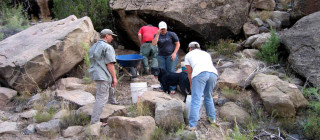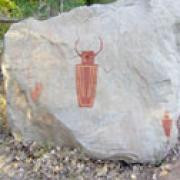Experimental Archaeology in Range Creek Canyon

Archaeologists conduct experiments to test hypotheses about how something might have been done in the past. In Range Creek, we try to recreate tasks the same way we think they might have been done by the Fremont 1,000 years ago. Conducting activities the way ancient people might have performed various tasks allows us to see if our actions produce the same results we see in the archaeological record. It is important that we conduct our experiments using the same resources, methods, and in the same environmental conditions that we are interested in. Because we will never be able to reproduce past behaviors exactly as they were, we use ethnography (record of contemporary and historically known people’s decisions and behaviors) and archaeology (material remains of past people’s behaviors) to help reconstruct the past.
Our experiments in Range Creek Canyon began in 2006, recording the costs and benefits of varying levels of investment in several technologies: granaries, nets, snares, and digging technology. These experiments have been designed and led by our staff and graduate students with the help of field school students each summer. Some of the most striking features of the archaeological record in Range Creek have been the reliance on maize farming, the variety and placement of storage structures, and the rock art left behind by the prehistoric inhabitants. No location appears to have been out of the question for the construction of granaries out of stone, mud, and wood. Beyond their construction and aesthetic qualities, we began to ask questions about the amount of time and effort required to construct irrigation features or create such impressive storage structures. While it is easy to discuss such topics around camp at the end of the day it is quite another to actually recreate the process and record the results of our own decisions. No other projects have given the insights we have gained from learning by doing!
Maize Farming Experiments
Beginning in 2013, we initiated a series of small farm plots, focusing on the costs and benefits of irrigating an heirloom variety of maize in Range Creek Canyon. We had always heard it was too costly for Fremont farmers to irrigate their crops without metal shovels or horses/plows to aid in the labor. Finding ethnographic accounts that recorded those costs was difficult as most historic and contemporary farmers use technology not available 1,000 years ago, thus changing the costs. We decided to gather that data ourselves by digging irrigation ditches using digging sticks and building diversion dams by hand like the Fremont. We measured the time that went into each activity: field preparation, planting, constructing irrigation systems, weeding, and harvesting. Then we analyze the kernels and cobs to determine the yields of the resulting harvests. We continue the experiments yearly to see how our costs and benefits change through time.
What is Experimental Archaeology
When the archaeological and ethnographic records leave questions about how people made decisions in the past, conducting an experiment can help archaeologists gather the missing data. Here we look at what experimental archaeology is and some of the questions it might inform on.
Watch The Video
We Tried Growing Corn the Fremont Way
When we couldn’t find quantitative data on how prehistoric farmers grew maize in Range Creek Canyon, we had to collect it ourselves by trying to grow corn the way Fremont farmers might have 1,000 years ago.
Watch The Video
We Learn from Every Flood, Pest, and Blister
Farming maize without the technology that contemporary farmers use today is very difficult! Our experiments taught us how incredible the Fremont were at solving the problems of arid land farming in the past.
Watch The Video
Building & Using a Granary
The construction of the granary would be first but before we could begin a few logistic requirements had to be met. First, a location had to be chosen. A spot close to the road and ranch complex was chosen to make it easy and safe to access and work on at the end of a long day. A suitable spot under a boulder, a few hundred meters north of the ranch house and a few meters off of the road was agreed upon.
Next, building material had to be collected. Using the ranch truck, hundreds of pounds of rock and dirt loaded into the bed and dropped off at the building site. When construction began, the area under the boulder was cleared and leveled, then a layer of juniper bark, followed by a layer of rock and then mud were laid down to form the foundation. The granary was constructed on top of this and allowed to dry. After it was dried, cracks that had appeared were patched, allowed to dry again and then the granary was loaded with dried field corn (still on the cob) the capstone was placed and the entire structure was sealed and left for the winter.
Rock Art Experiments

The rock art experiment followed a similar path. A large, unsheltered boulder found several meters south of the ranch and that is fully exposed to rain and wind was chosen as the location. Next, natural red and yellow pigments were collected from the surrounding cliffs and ground into a fine powder using an expediently produced mano and metate. The powder was mixed with creek water to form a loose paste and then a variety of images were painted onto to the boulder. These, like the granary, will be left to weather naturally and periodically photographed to record their degradation.
Flintknapping
Many of the field school students try their hand at making projectile points. Based on the waste materials found on archaeological sites we know that the prehistoric people living in Range Creek used mostly cherts and quartzites to produce the stone tools they needed. A source for these materials inside the canyon has not been found. We think and it is likely that the ancient flintknappers had to walk to the Green River to find chert and quartzite cobbles carried by floodwaters from upstream sources. Students practice on these materials and obsidian. They use the same type of tools used centuries ago: quartzite cobble hammerstones, antler base billets, and antler point pressure flakers. Many of the students are able to produce a usable point quite quickly. This exercise has practical applications. Students gain an understanding of the different types of flakes created during the production of a tool which can then be used when describing flakes found on prehistoric sites.
Hide Preparation
2010 field school students were taught basic techniques of hide (deer, buffalo, and elk) preparation by Teaching Assistant Rick Chapoose. Rick, a member of the Ute Tribe, has spent many years learning the traditional practices of Ute and other Native American Tribes. Using a combination of tools and techniques students scraped and softened the hides. Once prepared, these hides may be used to construct a host of valuable items including clothing, bags, straps, and shelter. Experiments such as this provide insight on the costs (i.e. time, materials, effort) associated with such activities.
Teepee Construction
Rick Chapoose demonstrated teepee construction to students of the 2010 archaeological field school as well. Rick's presentation included the techniques necessary to acquire and prepare lodgepoles and hide coverings. Traditional practices such as physical orientation and the positioning of interior features were discussed. Working together students then erected and dismantled the teepee.
With these experiments and others like them, we hope to answer or address several questions important to the archaeology of the canyon. These include requirements of time, materials, and manpower for construction and how those requirements might change as a result of more challenging locations; the techniques involved with native construction practices; and how effective were our experiments in terms of accomplishing their required tasks. Was the corn protected from animals and weather over the course of the winter and how long will the rock art last in a completely exposed environment? Updates to these experiments will be posted as they are repeated yearly to record variation over time.